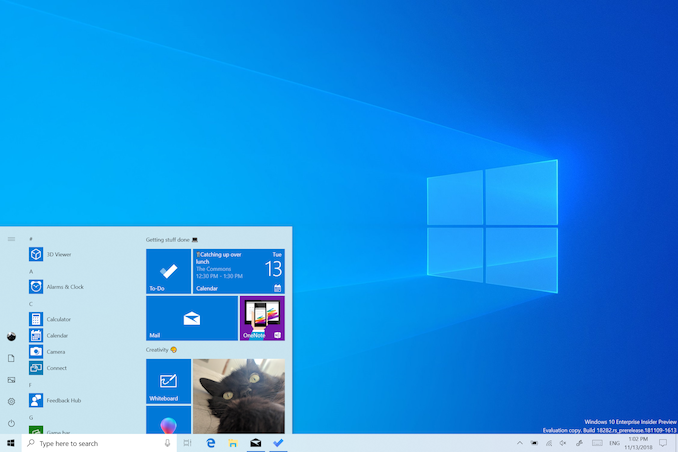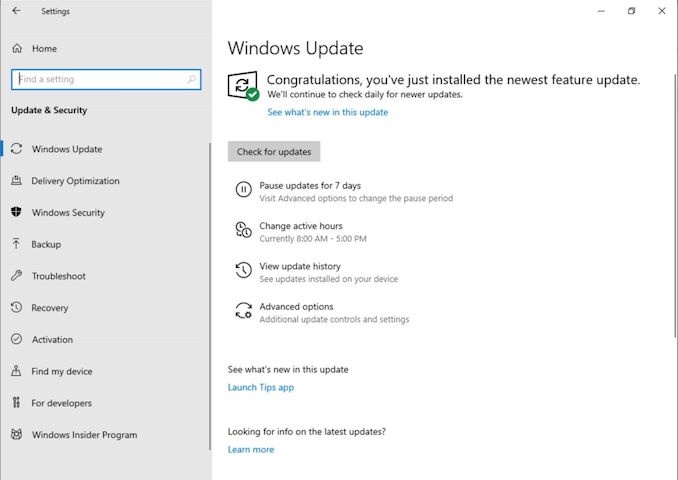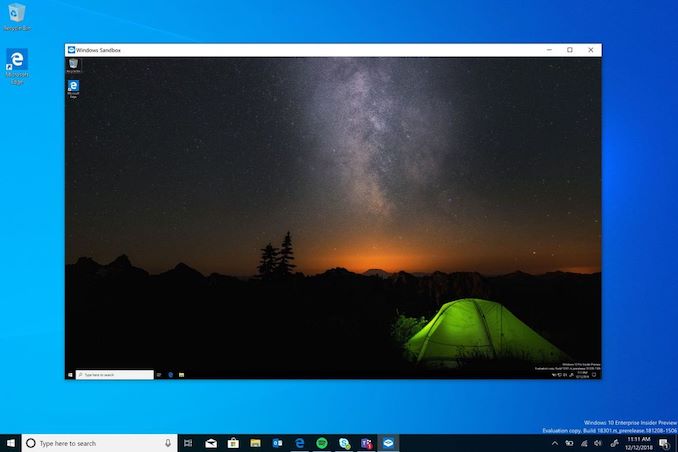A New Approach To Updates: Windows 10 May 2019 Update Available Today
by Brett Howse on May 21, 2019 9:15 PM EST- Posted in
- Operating Systems
- Software
- Microsoft
- Windows 10

For those eager to get the latest and greatest production build of Windows 10; good news. For those who would rather watch from the sidelines until the kinks are worked out; good news. Today Microsoft has officially launched the spring 2019 update for Windows 10, affectionately called the Windows 10 May 2019 Update. There’s a few new features under the hood, but the biggest change to Windows 10 this time is not a new feature you may or may not use, but instead a new approach to updates. And, after almost four years of users not being in control, Microsoft has put the control back in the hands of the people using their OS. Finally.
I’m not going to pine on about days gone past, but one of the biggest changes to Windows 10 when it launched was that the update system was going to be better. Improved. More reliable. Except it wasn’t. Some changes, such as the cumulative updates, have been a huge relief for people setting up new machines, since they no longer needed to update their computer for several days. An update comes every month which should have everything you need to get you to current in one batch. This was a win for end users. However, Windows 10 also brought about a new idea called feature updates, where occasionally, a new version of Windows would come down the same pipe as a normal update. Assuming everything was well tested, the update should install with little fanfare, but as we know that’s not been the case. Windows is on far too many machines to make any update easy, and Microsoft’s feedback mechanism for update issues was not being monitored as it needed to, which lead to multiple feature updates with enough major problems that even the last update from October is only now being pushed out to some machines.
So today we get Windows 10 1903, or the May 2019 Update, and home users will finally get an option to pause updates even if they are using Windows 10 Home. It’s a small step, but coupled with a very measured rollout, hopefully this will be the smooth update Microsoft has been craving for the last couple of years. For those looking for further transparency, Microsoft has a Windows release health dashboard, which shows the status of current known issues, letting you know ahead of time if you may have an incompatible piece of software or hardware.
There are of course new features as well, since this is in fact a feature update for Windows 10. There’s a new light theme, providing a refreshing look for Windows 10 which pairs nicely with the dark mode that arrived a couple of versions ago. Cortana is no longer part of the search bar, and now lives on its own app icon on the task bar. More default applications can now be removed.
There’s more complex features as well, such as Windows Sandbox, which allows you to run an application in a virtualized container for testing without it having access to the system files. Think of it like Hyper-V, but without the complexity. It’s not as powerful as Hyper-V, but it’s also much easier to set up and use.
There’s a few other features as well that we’ll go through in a more comprehensive article after we’ve had time to dig through some of the new abilities. That being said, updates are now offering fewer and fewer big changes, which makes sense due to the maturity of Windows 10 now. Plus, with the lack of stability, it makes sense to offer less user-facing features that are more stable, rather than continue to offer a multitude of new things that may or may not get used.
For those looking to get a jump-start on the upgrade process, Windows 10 May 2019 Update is currently rollout out via Windows Update where you can just check for updates, and you’ll receive it if your computer doesn’t have any blocking hardware or software. Microsoft is taking a very measured and cautious approach here, which is the right thing to do. For those that don’t want to wait for Windows Update, you can always check out the Windows 10 Download page to get the update right now.
Source: Windows Blog












43 Comments
View All Comments
Opencg - Wednesday, May 22, 2019 - link
I would love all of thisQasar - Wednesday, May 22, 2019 - link
Drazick like mooninite said.. .just install linux then :-) but i do like points #1, 2, and 5HStewart - Wednesday, May 22, 2019 - link
This sounds like a Windows Lite mode. Reduce over head - I could see how it could be used to play games. That would be nice.piroroadkill - Wednesday, May 22, 2019 - link
If only they concentrated on performance and removing gimmicks, Windows would be much betterSpunjji - Wednesday, May 22, 2019 - link
For whom? Remember, you're not representative of the majority of Windows users.imaheadcase - Wednesday, May 22, 2019 - link
The biggests flaw of the file system is the UI itself. The UI won't save settings, hasn't since win xp. A good example would be preview large pictures, you can't apply to network drives the settings, so it caches it on PC as large file, which in turn slows down UI browsing. Windows does weird stuff with file browsing, wish i could find a good UI replacement.Carmen00 - Wednesday, May 22, 2019 - link
1. Background processes are largely "free" with good OS schedulers and multiple cores, so who cares how many there are? About memory, I'm not sure what you're seeing, but on my current box the vast majority of Windows background services are taking up less than 3Mb each, so who cares if there are 150 of them running?2. They've been doing this for the last 2 releases and are continuing to do this.
3. Linux is pitiful when it thrashes the disk. So is Windows. Windows' network stack isn't as good, though. Is that what you're referring to? Be specific.
4. When you say "Linux like performance", are you talking about Ext4? XFS? JFS? BTRFS? Because all of those have radically different performance characteristics.
5. I think they sell a stripped-down version for kiosks and the like. Is that what you want?
Mr Perfect - Wednesday, May 22, 2019 - link
Replacing NTFS would be grand too. Wonder why they backed off of ReFS so fast?ooogemaflop - Wednesday, May 22, 2019 - link
Commutative updates are not new . Do not be kidded my Microsofts terminologyFeature updates are no different to what the service packs were of XPs days no matter how much Microsoft want us to think different
ooogemaflop - Wednesday, May 22, 2019 - link
by not my